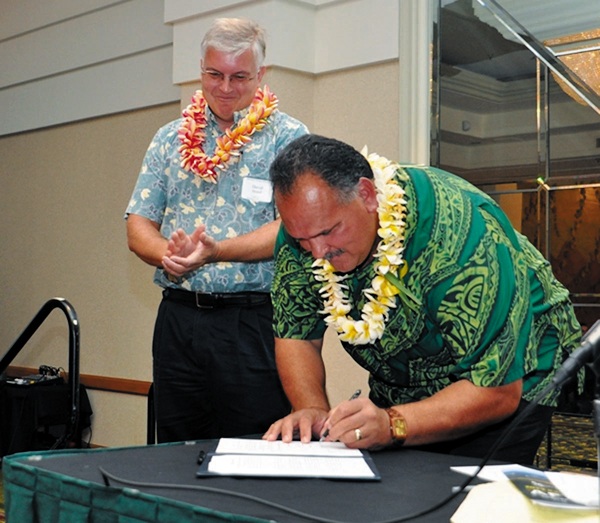LIHUE — Hawaii State Senator Mike Gabbard will be the first to tell you that Hawaii must kick its addiction to foreign fossil fuels. And his daughter, Congresswoman Tulsi Gabbard, is going to do everything she can to help, according
LIHUE — Hawaii State Senator Mike Gabbard will be the first to tell you that Hawaii must kick its addiction to foreign fossil fuels. And his daughter, Congresswoman Tulsi Gabbard, is going to do everything she can to help, according to the senator.
“She better, or else,” Gabbard joked, drawing laughter from the approximately 150 people gathered Thursday for the 2013 Kauai Energy Conference.
Hosted by the Kauai Economic Development Board, the sixth annual conference, with the theme After Oil: Managing the Transformation, was held at the Kauai Marriott Resort and Beach Club in Lihue, and featured speeches by more than 20 renewable energy sector leaders.
Each year, the state of Hawaii spends between $4 and $6 billion on its energy needs, according to Gabbard, who also serves as chair of the Senate Committee on Energy and Environment.
“This is crazy and stupid since we have so many world class renewable energy resources built into our island paradise,” he said.
On Kauai, imported oil accounts for 85 percent of the fuel used to generate electricity by Kauai Island Utility Cooperative, and accounts for more than $100 million being sent off island annually. But that will soon change.
Gabbard thanked and congratulated Kauai for doing its part to ensure the state becomes a world leader in clean, renewable energy.
“To arrive at this place is not going to be easy,” he said. “We’re going to have to all make sacrifices.”
During the conference, Kauai Mayor Bernard Carvalho Jr. and KIUC President and CEO David Bissell announced and signed a memorandum of understanding that “commits the utility and local government to work together toward a goal of reducing the island’s consumption of fossil fuels and lowering the cost of energy for its residents,” according to a release.
The memorandum was unanimously approved by the KIUC Board of Directors at its July 30 meeting.
“Kauai is blessed as the only island in the state to be served by a utility that is a member-owned cooperative,” Carvalho said. “We are committed to collaborating with KIUC on innovative ways to reduce our fossil fuel dependence and integrate more renewable energy on Kauai’s grid.”
In 2013, the county was KIUC’s largest customer, consuming more than 20 million kilowatt hours of electricity at a cost of more than $8 million.
By 2023, KIUC’s goal is to generate 50 percent of its power from renewable resources, which could reduce the amount of oil consumed by KIUC by about 15 million gallons per year.
“This agreement puts in writing what’s been happening informally — collaboration between the county and KIUC to put our best efforts toward reducing Kauai’s oil dependency,” Bissell said. “Mayor Carvalho’s administration has been especially proactive on energy issues and his Holo Holo 2020 initiative is closely aligned with KIUC’s own strategic plan to reduce utility bills, cut greenhouse gas emissions and increase our energy self-sufficiency.”
Many potential solutions to get there were discussed Thursday, including biomass, biofuels, hydropower and solar.
In 2007, 94.3 percent of KIUC’s power was generated by oil, while 5.4 percent came from hydro and 0.3 from biomass. This year, oil accounts for 85 percent, while hydro jumped to 9 percent and solar came in at 6 percent.
KIUC’s Power Supply Manager Brad Rockwell said 2014 is the year that Kauai will begin to see a number of large projects come online, including two 12-megawatt solar projects and a 6.7-megawatt biomass facility near Koloa.
By mid-2014, the co-op expects to reduce oil to 63 percent of its total energy generation, while solar will account for 16 percent, biomass for 12 percent and hydro for 9 percent.
“As you can see, we’re about to take quite a big bite out of oil, really quickly,” Rockwell said. “And that’s a big shift. We’re going to be down to about two-thirds oil and about one-third renewable by the end of 2014.”
KIUC will consume approximately 28 million gallons of fuel this year. However, once the large solar and biomass projects are complete, that number will drop to approximately 21 million gallons, translating to about $22 million that will stay on Kauai, according to Rockwell.
“That’s a huge boost to our local economy,” he said.
As for reaching the goal of 50 percent renewable energy by 2023, Rockwell said additional solar and hydro will likely play a large parts, but that they come with challenges, including community resistance.
“Unlike oil, which is very energy dense, many renewable project require space, and that is in people’s face,” he said. “We really need buy-in from the whole community if we’re going to get support for these types of things.”
Palo Luckett, co-founder of Pacific Light and Power Inc., said in the past five years there has been a “tremendous shift” in the way power is generated on Kauai. He credits the leadership and vision of the co-op as an early adopter of renewable resources.
“And if you keep the momentum going I think what is happening on Kauai will clearly be a model for not only the rest of the United States, but globally,” he said.
Gabbard shared his “wish list” for Hawaii’s energy future, which included making use of all renewable resources and getting electrical prices under control, so that people can use their hard-earned money to feed and clothe their families.
To do that, Gabbard said there must be “laulima,” or “many hands working together.”
“It will take the public and the private sector, communities putting aside their differences and working for the common good.”



